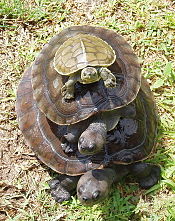Asian leaf turtle
This article includes a list of general references, but it lacks sufficient corresponding inline citations. (October 2015) |
| Asian leaf turtle | |
|---|---|

| |
| Scientific classification | |
| Domain: | Eukaryota |
| Kingdom: | Animalia |
| Phylum: | Chordata |
| Class: | Reptilia |
| Order: | Testudines |
| Suborder: | Cryptodira |
| Superfamily: | Testudinoidea |
| Family: | Geoemydidae |
| Genus: | Cyclemys |
| Species: | C. dentata
|
| Binomial name | |
| Cyclemys dentata (Gray, 1831)
| |

| |
| Cyclemys dentata range map | |
| Synonyms[2] | |
| |
The Asian leaf turtle (Cyclemys dentata) is a species of turtle found in Southeast Asia. They are quite common in the pet trade; their carapaces resemble that of a Cuora amboinensis hybrid.
Feeding
This species is omnivorous and feeds on vegetation and fruits, and also mollusks, crustaceans and fish. It is also known to be scavenger and very often seen to take carrion.
Behavior
The Asian leaf turtle is quite elusive and sighting is uncommon.[3] It is not strong swimmer preferring instead to walk on the bottom of a body of water rather than swimming freely. According to Das, the adult spends its nights on land and moves to water during the day.[4] It will squirt its digestive system contents when it feels threatened.[5]
Size
Asian leaf turtles can grow 6 to 9.5 inches (15 to 24 cm) long and 4.5 to 6.5 inches in width.
Distribution
The turtle can be found in North India, North-east India (Manipur), Bangladesh, Myanmar (Burma), Thailand, Cambodia, Vietnam, West Malaysia, Indonesia (Sumatra, Java, Borneo, Bali), Philippines (Palawan: Calamian Islands etc.), and China.[6]
This species is found up to 1,200 m of elevation, but the depth range is unknown.[7]
References
- ^ As-singkily, M.; Guntoro, J.; Kusrini, M.D.; Schoppe, S. (2021). "Cyclemys dentata". IUCN Red List of Threatened Species. 2021: e.T195849722A2929066. doi:10.2305/IUCN.UK.2021-1.RLTS.T195849722A2929066.en. Retrieved 19 November 2021.
- ^ Fritz Uwe; Peter Havaš (2007). "Checklist of Chelonians of the World" (PDF). Vertebrate Zoology. 57 (2): 220. ISSN 1864-5755. Archived from the original (PDF) on 1 May 2011. Retrieved 29 May 2012.
- ^ http://www.ecologyasia.com/verts/turtles/asian-leaf-terrapin.htm
- ^ http://www.chelonia.org/Articles/Cyclmeyscare.htm
- ^ https://www.reptilesmagazine.com/philippine-authorities-arrest-3-for-possessing-threatened-turtles/
- ^ https://reptile-database.reptarium.cz/species?genus=Cyclemys&species=dentata
- ^ https://www.mybis.gov.my/sp/9951
- Farkas B.; Gyurján I. (1998). "Geographic Distribution. Cyclemys dentata". Herpetological Review. 29 (1): 50.
- Fritz U.; Gaulke M.; Lehr E. (1997). "Revision der südostasiatischen Dornschildkröten-Gattung Cyclemys Bell 1834, mit Beschreibung einer neuen Art". Salamandra. 33 (3): 183–212.
- Gaulke Maren (1995). "On the distribution of Emydid turtles and the Anuran genus Microhyla in the Philippines Asiatic". Herpetological Research. 6: 49–52. doi:10.5962/bhl.part.7986.
- Gaulke Maren; Fritz Uwe (1998). "Distribution patterns of batagurid turtles in the Philippines (Testudines: BataguridaCuora, Cyclemys, Heosemys)". Herpetozoa. 11 (1/2): 3–12.
- Gray, J.E. 1857 Notice of some Indian tortoises (including the description of a new species presented to the British Museum by Professor Oldham). Ann. Mag. Nat. Hist. (2) 19: 342-344
- Gray, J.E. 1864 Observations on the box tortoises, with the description of three new Asiatic species. Ann. Mag. Nat. Hist. (3) 13: 105-111
- Gray, J.E. 1873 On the original form, development, and cohesion of the bones of the sternum of chelonians; with notes on the skeleton of Sphargis. Ann. Mag. nat. Hist. (4) 11: 161-172


